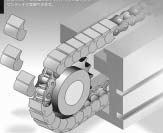Calculation of Chain Tension
Generally, to start with, tentatively ascertain the chain dimension to become used referring to “Tentative determination of chain size”. Then, get “Theoretical chain stress (T)” (P213) to the tentatively established chain, and multiply the value by “Speed coefficient (K)”, to obtain “Substantial chain stress (Ta)”. For security, the significant chain stress has to be reduced than the “maximum allowable tension” stated within the table of dimensions of respective chains. Consequently, the situation under needs to be satisfied.
Safety issue of chain stress
Significant chain stress (Ta) =Theoretical chain tension (T) ×Speed coefficient (K)
Substantial chain stress (Ta) <Maximum allowable stress
If this problem will not be pleased, choose a bigger chain by one particular dimension and re-calculate.
Tentative determination of chain dimension
qDetermine the mass (excess weight) per unit length of components this kind of as chain and attachment ωc (kg/m or kgf/m) assuming that it is 10 percent from the mass (bodyweight) from the conveyed object ω1 (kg/m or kgf/m).
wIn reference towards the calculation formulas on, receive “Theoretical chain stress (T)” (kN or kgf) and “Speed coefficient (K)”, and determine “Substantial chain tension (Ta)” (kN or kgf).
eIn reference on the table of dimensions of chains,recognize the minimum chain, whose “maximum allowable tension” is larger than the “Substantial chain tension (Ta)”, and regard it as “tentatively decided chain”.
Value of pace coefficient (K)
The pace coefficient (K) expresses the severity of operation condition according towards the traveling pace of chain since the ailment becomes severer because the traveling velocity of chain gets to be greater.
Multiply “Theoretical chain tension (T)” by “Speed coefficient (K)” to get “Substantial chain stress (Ta)”.
After you style and design many conveyor techniques making use of modest conveyor chains, the following simple situations need to be content.
a. Chain stress: The real tensile strength in operation has to be considerably lower compared to the specified power of the chain.
b. Strength of loaded parts of chain: The real loads applied to attachments, such as rollers of base chain, prime rollers, side rollers, and so forth. in operation have to be considerably smaller sized than the strength of those elements.
c. Wear daily life of chain: Lubrication problems to be sure the wear existence of chain needs to be fulfilled.
d. Sag adjustment of chain: The sag with the chain must be kept optimum by tension adjusters, take-up products, guides, and so on.
e. Other people: Appropriate measures are taken  to stop rail dress in, machine vibration and various difficulties.
to stop rail dress in, machine vibration and various difficulties.
The following complement the above.
